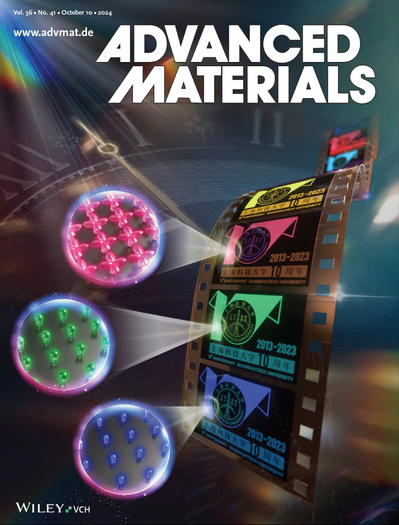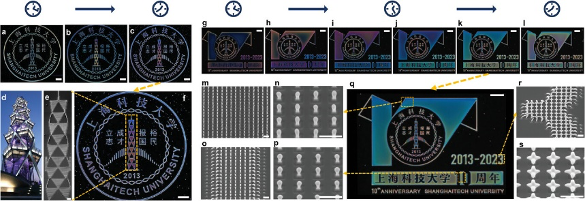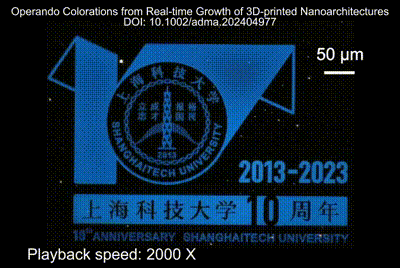Nature produces colors in several different ways, from the vibrant blues of a morpho butterfly’s wings to the iridescent hues of an opal and the ever-changing colors of a chameleon’s skin. These fascinating colorations, known as structural colors, result from the diffraction of light from nanostructures. After millions of years of evolution, the structural colors have long captivated scientists and engineers who seek to replicate the phenomenon and harness its potential. Owing to their non-fading, eco-friendly, biocompatible, and color-tunable properties, structural colors are ideal for applications in display, strain sensors, environment sensors, biological sensors, and security.
“We’ve learned a lot from nature, but once you learn the physics you can go beyond nature. That’s what we scientists do!” added Feng Jicheng, Assistant Professor from the School of Physical Science and Technology (SPST) at ShanghaiTech University.
Replicating nature’s precision at the nanoscale, however, has proven to be a formidable challenge. Conventional fabrication techniques, such as electron beam lithography, can create intricate nanostructures, but are slow, expensive, and mostly limited in the two-dimensional geometries. Meanwhile, additive manufacturing methods that have revolutionized other areas of production have struggled to achieve the necessary resolution and material control at the nanometer scale.
Our life experience told us that most colors fade over time. In contrast, Feng’s group has developed an additive approach to diversify colors over time. This enrichment was realized by operando observation and measurement of the real-time growth of nanostructures during nanoprinting (The 3D-nanoprinting system was devised by Feng’s group and protected by a great number of patents.).
In the research, Feng’s group smartly used plasmonics of subwavelength 3D metal-nanostructures for dynamic colors. At the interface between the metal-nanostructure and dielectric, surface plasmons provide high pixel density and flexible modulation. The nanoprinting system can powerfully print large arrays of nanostructures, enabling colors to be in situ observed and measured during nanoprinting. Each array of nanostructures was printed onto independent square areas that acted as color palettes. In a single print, a specific array (consisting of 100x100 nanostructures) corresponded to the historical development of rich colors, and 64 of such different arrays were simultaneously printed, thereby making the correspondingly color palettes.
Apart from controlling the structural geometries, they elegantly introduced the fourth dimension “time” to diversify the colors even more. Their exciting results confirm that the nanoprinting technology enables the 4D printing of a magnificent library of dynamic colors, which are expected to be rapidly adopted for practical applications ranging from surface decoration, digital displays, and molecular sensing to optical security devices and durable optical data storage.
With the help of machine-learning, Feng’s group will further develop this color-monitoring tool for online measurement of the structural dimensions and geometries.

Figure. 1 Illustration to the 3D-printed dynamic colors. Each color square represents its own typical color histories in the CIE diagram. A single print cycle realized the printing of thousands of such squares that differs in their colors, because the structural geometries and dimensions were controlled in nanoprinting.
This unique work, recently published in the journal Advanced Materials in an article entitled “Operando Colorations from Real-Time Growth of 3D-Printed Nanoarchitectures,” has made a significant advance in the field of structural color fabrication. PhD student Liu Bingyan from SPST is the first author of this work, and the corresponding author is Prof. Feng Jicheng. Additionally, the journal Advanced Materials selected it as the back cover.

Figure 2. Cover image: The real-time colors are visually mimicked by the flower blooming, as shown by the three frames (i.e., arrays) in the image. Arrays of the nanostructures with different geometries evolve their own unique color trajectories during nanoprinting. Such flowery nanostructures are picked up among the regions from the ShanghaiTech’s 10th anniversary logo, which dynamically evolves in a manner like filming a movie at microscopic scale. The three-dimensional control to the nanostructures, together with the time as the fourth dimension, realizes the 4D printing of “colorful micro-movies”. A clock was used as the background to indicate that our 3D nanoprinting technique allows for the real-time observation and control of color generation during the fabrication process itself.
The leading science news portal (Nanowerk) complimented on the advancement of the work (3D nanoprinting technique enables real-time observation of structural color formation), reading as:
“This work represents a significant advance in the field of structural color and nanofabrication more broadly. By enabling real-time observation and control of color generation at the nanoscale, it opens up new avenues for both fundamental research and practical applications. This work serves as a powerful demonstration of how converging technologies in nanofabrication, optics, and materials science can open up new frontiers in our ability to manipulate light and color.”

Figure 3. Real-time colors measured both spectrally and visually. Only one single print can adequately collect several thousand datapoints to the color diagram, even exceeding that defined by the sRGB frame.


Figure 4. Arrays of nanostructures with different geometries side by side evolve their own unique color trajectories during nanoprinting. The real-time nature of the color generation also opens up new possibilities for dynamic and animated structural colors. As a proof of concept, Feng’s group realized the printing of the ShanghaiTech’s 10th anniversary logo, recording the evolution of its colors throughout the printing process.
About Feng’s Lab
Feng’s lab, Aerosol Intelligence Laboratory (AIL), aims at mapping out the future of system-level integration with the new nanoprinting solutions. Based on the understanding of Faraday 3D printing, Feng’s group weave together various possibilities for making the next-generation nanoelectronics and nanophotonics. More details about Feng’s group can be found at www.jcfenglab.com.
*This article is provided by Prof. Feng

